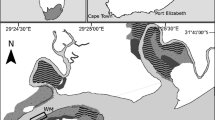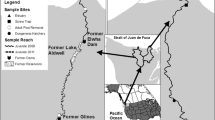Abstract
Establishing links between migration patterns and trophic dynamics is paramount to ecological studies investigating the functional role habitats provide to resident and transient species. Natural tags in fishes, such as otolith chemistry and tissue stable isotopes, can help reconstruct previous environmental and dietary histories, although these approaches are rarely combined. A novel multiproxy natural tag approach was developed to estimate immigration patterns of juvenile Atlantic croaker Micropogonias undulatus, across contrasting salinity gradients in three subtropical estuaries of the western Gulf of Mexico. Juvenile young-of-year Atlantic croaker were collected along a latitudinal gradient that included positive, neutral, and negative estuaries, based on physicochemical (temperature, salinity, dissolved element) and isotopic (δ15N and δ13C) parameters. Otolith elemental chronologies of Sr/Ca and Ba/Ca were used to classify migratory types within each estuary, while tissue-specific isotope ratios revealed time since recent (liver~weeks) and longer term (muscle~months) diet shifts. Nitrogen isotopes in both liver and muscle tissues were highly correlated, suggesting tissue equilibrium and estuarine residence of at least 3 months, with geographic δ15N gradients reflecting the magnitude of anthropogenic nutrient enrichment within each estuary. Differences in isotopic equilibrium of muscle-liver δ13C values and variation in marginal edge otolith Sr/Ca and Ba/Ca suggested recent shifts in carbon source and habitat utilization, reflecting individualized movement across seascapes and connectivity of habitat mosaics. The multiproxy approach presented here identified diverse migration patterns and linked feeding and movement on regional (inter-estuary), local (intra-estuary), and individual scales to improve our understanding of habitat function across estuarine gradients.








Similar content being viewed by others
References
Able, K.W. 2005. A re-examination of fish estuarine dependence: evidence for connectivity between estuarine and ocean habitats. Estuarine, Coastal and Shelf Science 64 (1): 5–17. https://doi.org/10.1016/j.ecss.2005.02.002.
Albuquerque, C.Q., N. Miekeley, J.H. Muelbert, B.D. Walther, and A.J. Jaureguizar. 2012. Estuarine dependency in a marine fish evaluated with otolith chemistry. Marine Biology 159 (10): 2229–2239. https://doi.org/10.1007/s00227-012-2007-5.
Beck, M.W., K.L. Heck, K. Able, D.L. Childers, D.B. Eggleston, B.M. Gillanders, B. Halpern, et al. 2001. The identification, conservation, and management of estuarine and marine nurseries for fish and invertebrates. Bioscience 51 (8): 633–641.
Bishop, K.A., J.W. Mcclelland, and K.H. Dunton. 2017. Freshwater contributions and nitrogen sources in a south Texas estuarine ecosystem: a time-integrated perspective from stable isotopic ratios in the eastern oyster (Crassostrea virginica). Estuaries and Coasts 40 (5): 1314–1324. https://doi.org/10.1007/s12237-017-0227-0.
Burke, J.S., D.S. Peters, and P.J. Hanson. 1993. Morphological indices and otolith microstructure of Atlantic croaker, Micropogonias undulatus, as indicators of habitat quality along an estuarine pollution gradient. Environmental Biology of Fishes 36 (1): 25–33.
Cowan, J.H. 1988. Age and growth of Atlantic croaker, Micropogonias undulatus, larvae collected in the coastal waters of the northern Gulf of Mexico as determined by increments in saccular otoliths. Bulletin of Marine Science 42: 349–357.
Dahlgren, C.P., G.T. Kellison, A.J. Adams, B.M. Gillanders, M.S. Kendall, C.A. Layman, J.A. Ley, I. Nagelkerken, and J.E. Serafy. 2006. Marine nurseries and effective juvenile habitats: concepts and applications. Marine Ecology Progress Series 312: 291–295. https://doi.org/10.3354/meps312291.
Dierking, J., F. Morat, Y. Letourneur, and M. Harmelin-Vivien. 2012. Fingerprints of lagoonal life: migration of the marine flatfish Solea solea assessed by stable isotopes and otolith microchemistry. Estuarine, Coastal and Shelf Science 104–105: 23–32. https://doi.org/10.1016/j.ecss.2011.03.018.
Fodrie, F.J., and S.Z. Herzka. 2013. A comparison of otolith geochemistry and stable isotope markers to track fish movement: describing estuarine ingress by larval and post-larval halibut. Estuaries and Coasts 36 (5): 906–917. https://doi.org/10.1007/s12237-013-9612-5.
Fowler, A.J., S.E. Campana, C.M. Jones, and S.R. Thorrold. 1995. Experimental assessment of the effect of temperature and salinity on elemental composition of otoliths using laser ablation ICPMS. Canadian Journal of Fisheries and Aquatic Sciences 52 (7): 1431–1441.
France, R.L. 1995. Differentiation between littoral and pelagic food webs in lakes using stable carbon isotopes. Limnology and Oceanography 40 (7): 1310–1313.
Fry, B. 1983. Fish and shrimp migrations in the northern Gulf of Mexico analyzed using stable C, N, and S isotope ratios. Fishery Bulletin 81: 789–801.
Fry, B., R.S. Scalan, and P.L. Parker. 1977. Stable carbon isotope evidence for two sources of organic matter in coastal sediments: seagrasses and plankton. Geochimica et Cosmochimica Acta 41 (12): 1875–1877. https://doi.org/10.1016/0016-7037(77)90218-6.
Fry, B., D.M. Baltz, M.C. Benfield, J.W. Fleeger, A. Gace, H.L. Haas, and Z.J. Quiñones-Rivera. 2003. Stable isotope indicators of movement and residency for brown shrimp (Farfantepenaeus aztecus) in coastal Louisiana marshscapes. Estuaries 26 (1): 82–97. https://doi.org/10.1007/BF02691696.
Gillanders, B.M., and A.R. Munro. 2012. Hypersaline waters pose new challenges for reconstructing environmental histories of fish based on otolith chemistry. Limnology and Oceanography 57 (4): 1136–1148. https://doi.org/10.4319/lo.2012.57.4.1136.
Hernandez, F.J., S.P. Powers, and W.M. Graham. 2010. Detailed examination of ichthyoplankton seasonality from a high-resolution time series in the northern Gulf of Mexico during 2004–2006. Transactions of the American Fisheries Society 139 (5): 1511–1525. https://doi.org/10.1577/T10-001.1.
Herzka, S.Z., S.A. Holt, and G.J. Holt. 2002. Characterization of settlement patterns of red drum Sciaenops ocellatus larvae to estuarine nursery habitat: a stable isotope approach. Marine Ecology Progress Series 226: 143–156.
Hoover, R.R., C.M. Jones, C.E. Grosch, and B.M. Gillanders. 2012. Estuarine ingress timing as revealed by spectral analysis of otolith life history scans. Canadian Journal of Fisheries and Aquatic Sciences 69 (8): 1266–1277. https://doi.org/10.1139/f2012-058.
Izzo, C., Z.A. Doubleday, A.G. Schultz, S.H. Woodcock, and B.M. Gillanders. 2015. Contribution of water chemistry and fish condition to otolith chemistry: comparisons across salinity environments. Journal of Fish Biology 86 (6): 1680–1698. https://doi.org/10.1111/jfb.12672.
Kraus, R.T., and D.H. Secor. 2004. Incorporation of strontium into otoliths of an estuarine fish. Journal of Experimental Marine Biology and Ecology 302 (1): 85–106. https://doi.org/10.1016/j.jembe.2003.10.004.
Kupchik, M.J., and R.F. Shaw. 2016. Age, growth, and recruitment of larval and early juvenile Atlantic croaker (Micropogonias undulatus), determined from analysis of otolith microstructure. Fishery Bulletin 114 (1): 18–33. https://doi.org/10.7755/FB.114.1.2.
Limburg, K.E. 1998. Anomalous migrations of anadromous herrings revealed with natural chemical tracers. Canadian Journal of Fisheries and Aquatic Sciences 55 (2): 431–437. https://doi.org/10.1139/f97-219.
Matich, P., M.R. Heithaus, and C.A. Layman. 2011. Contrasting patterns of individual specialization and trophic coupling in two marine apex predators. Journal of Animal Ecology 80 (1): 294–305. https://doi.org/10.1111/j.1365-2656.2010.01753.x.
McClelland, J.W., I. Valiela, and R.H. Michener. 1997. Nitrogen-stable isotope signatures in estuarine food webs: a record of increasing urbanization in coastal watersheds. Limnology and Oceanography 42 (5): 930–937.
McMahon, K.W., L.L. Hamady, and S.R. Thorrold. 2013. A review of ecogeochemistry approaches to estimating movements of marine animals. Limnology and Oceanography 58 (2): 697–714. https://doi.org/10.4319/lo.2013.58.2.0697.
Miller, M.J., and K.W. Able. 2002. Movements and growth of tagged young-of-the-year Atlantic croaker (Micropogonias undulatus L.) in restored and reference marsh creeks in Delaware. Journal of Experimental Marine Biology and Ecology 267 (1): 15–33.
Mohan, J.A., and B.D. Walther. 2015. Spatiotemporal variation of trace elements and stable isotopes in subtropical estuaries: II. Regional, local, and seasonal salinity-element relationships. Estuaries and Coasts 38 (3): 769–781. https://doi.org/10.1007/s12237-014-9876-4.
Mohan, J.A., and B.D. Walther. 2016. Out of breath and hungry: natural tags reveal trophic resilience of Atlantic croaker to hypoxia exposure. Marine Ecology Progress Series 560: 207–221. https://doi.org/10.3354/meps11934.
Mohan, J.A., M.S. Rahman, P. Thomas, and B.D. Walther. 2014. Influence of constant and periodic experimental hypoxic stress on Atlantic croaker otolith chemistry. Aquatic Biology 20 (1): 1–11. https://doi.org/10.3354/ab00542.
Mohan, J.A., S.D. Smith, T.L. Connelly, E.T. Attwood, J.W. McClelland, S.Z. Herzka, and B.D. Walther. 2016. Tissue-specific isotope turnover and discrimination factors are affected by diet quality and lipid content in an omnivorous consumer. Journal of Experimental Marine Biology and Ecology 479: 35–45. https://doi.org/10.1016/j.jembe.2016.03.002.
Moser, M.L., and L.R. Gerry. 1989. Differential effects of salinity changes on two estuarine fishes, Leiostomus xanthurus and Micropogonias undulatus. Estuaries 12 (1): 35–41.
Nagelkerken, I., M. Sheaves, R. Baker, and R.M. Connolly. 2015. The seascape nursery: a novel spatial approach to identify and manage nurseries for coastal marine fauna. Fish and Fisheries 16 (2): 362–371. https://doi.org/10.1111/faf.12057.
Nelson, T.R., D.R. DeVries, and R.A. Wright. 2017. Salinity and temperature effects on element incorporation of gulf killifish Fundulus grandis otoliths. Estuaries and Coasts. https://doi.org/10.1007/s12237-017-0341-z.
Nixon, S.W., and C.M. Jones. 1997. Age and growth of larval and juvenile Atlantic croaker, Micropogonias undulatus, from the Middle Atlantic Bight and estuarine waters of Virginia. Fishery Bulletin 95: 773–784.
Palmer, T.A., P.A. Montagna, J. Beseres Pollack, R.D. Kalke, and H.R. DeYoe. 2011. The role of freshwater inflow in lagoons, rivers, and bays. Hydrobiologia 667 (1): 49–67. https://doi.org/10.1007/s10750-011-0637-0.
Paton, C., J. Hellstrom, B. Paul, J. Woodhead, and J. Hergt. 2011. Iolite: freeware for the visualisation and processing of mass spectrometric data. Journal of Analytical Atomic Spectrometry 26 (12): 2508–2518. https://doi.org/10.1039/c1ja10172b.
Peterson, B.J. 1999. Stable isotopes as tracers of organic matter input and transfer in benthic food webs: a review. Acta Oecologica 20 (4): 479–487. https://doi.org/10.1016/S1146-609X(99)00120-4.
Peterson, M.S., B.H. Comyns, C.F. Rakocinski, and G.L. Fulling. 1999. Does salinity affect somatic growth in early juvenile Atlantic croaker, Micropogonias undulatus (L.)? Journal of Experimental Marine Biology and Ecology 238 (2): 199–207.
Ray, G.C. 2005. Connectivities of estuarine fishes to the coastal realm. Estuarine, Coastal and Shelf Science 64 (1): 18–32. https://doi.org/10.1016/j.ecss.2005.02.003.
Reis-Santos, P., S.E. Tanner, S. França, R.P. Vasconcelos, B.M. Gillanders, and H.N. Cabral. 2015. Connectivity within estuaries: an otolith chemistry and muscle stable isotope approach. Ocean and Coastal Management 118: 51–59. https://doi.org/10.1016/j.ocecoaman.2015.04.012.
Rooker, J.R., S.A. Holt, M.A. Soto, and G.J. Holt. 1998. Postsettlement patterns of habitat use by sciaenid fishes in subtropical seagrass meadows. Estuaries 21 (2): 318–327.
Rooker, J.R., R.T. Kraus, and D.H. Secor. 2004. Dispersive behaviors of black drum and red drum: is otolith Sr:Ca a reliable indicator of salinity history? Estuaries 27 (2): 334–341. https://doi.org/10.1007/BF02803389.
Secor, D.H., A. Henderson-Arzapalo, and P.M. Piccoli. 1995. Can otolith microchemistry chart patterns of migration and habitat utilization in anadromous fishes? Journal of Experimental Marine Biology and Ecology 192 (1): 15–33.
Sheaves, M., R. Baker, I. Nagelkerken, and R.M. Connolly. 2014. True value of estuarine and coastal nurseries for fish: incorporating complexity and dynamics. Estuaries and Coasts 38 (2): 401–414. https://doi.org/10.1007/s12237-014-9846-x.
Sturrock, A.M., C.N. Trueman, J.A. Milton, C.P. Waring, M.J. Cooper, and E. Hunter. 2014. Physiological influences can outweigh environmental signals in otolith microchemistry research. Marine Ecology Progress Series 500: 245–264. https://doi.org/10.3354/meps10699.
Thorrold, S.R., and S. Shuttleworth. 2000. In situ analysis of trace elements and isotope ratios in fish otoliths using laser ablation sector field inductively coupled plasma mass spectrometry. Canadian Journal of Fisheries and Aquatic Sciences 57 (6): 1232–1242. https://doi.org/10.1139/f00-054.
Thorrold, S.R., C.M. Jones, and S.E. Campana. 1997. Response of otolith microchemistry to environmental variations experienced by larval and juvenile Atlantic croaker (Micropogonias undulatus). Limnology and Oceanography 42 (1): 102–111.
Tolan, J.M. 2007. El Niño-southern oscillation impacts translated to the watershed scale: estuarine salinity patterns along the Texas Gulf Coast, 1982 to 2004. Estuarine, Coastal and Shelf Science 72 (1-2): 247–260. https://doi.org/10.1016/j.ecss.2006.10.018.
Trueman, C.N., K.M. Mackenzie, and M.R. Palmer. 2012. Identifying migrations in marine fishes through stable-isotope analysis. Journal of Fish Biology 81 (2): 826–847. https://doi.org/10.1111/j.1095-8649.2012.03361.x.
Vasconcelos, R.P., P. Reis-Santos, M.J. Costa, and H.N. Cabral. 2011. Connectivity between estuaries and marine environment: integrating metrics to assess estuarine nursery function. Ecological Indicators 11 (5): 1123–1133. https://doi.org/10.1016/j.ecolind.2010.12.012.
Walther, B.D., and K.E. Limburg. 2012. The use of otolith chemistry to characterize diadromous migrations. Journal of Fish Biology 81 (2): 796–825. https://doi.org/10.1111/j.1095-8649.2012.03371.x.
Warlen, S.M., and J.S. Burke. 1990. Immigration of larvae of fall/winter spawning marine fishes into a North Carolina estuary. Estuaries 13 (4): 453–461. https://doi.org/10.1007/BF02689333.
White, M.L., and M.E. Chittenden. 1977. Age determination, reproduction, and population dynamics of the Atlantic croaker, Micropogonias undulatus. Fishery Bulletin 75: 109–123.
Acknowledgements
We thank the Texas Water Development Board and S. Negusse for providing salinity data; Texas Parks Wildlife Department including F. Grubbs, Z. Olsen, N. Ahrens, B. Grimmett, B. Balboa, and M. Fisher for providing samples; and J. Ripley, N. Miller, and B. Hendrickson for help with sample analysis. Two anonymous reviewers and Associate Editor M.D. Taylor greatly improved this manuscript.
Author information
Authors and Affiliations
Corresponding author
Additional information
Communicated by Matthew D. Taylor
Electronic supplementary material
ESM 1
(PDF 1021 kb)
Rights and permissions
About this article
Cite this article
Mohan, J.A., Walther, B.D. Integrating Multiple Natural Tags to Link Migration Patterns and Resource Partitioning Across a Subtropical Estuarine Gradient. Estuaries and Coasts 41, 1806–1820 (2018). https://doi.org/10.1007/s12237-018-0385-8
Received:
Revised:
Accepted:
Published:
Issue Date:
DOI: https://doi.org/10.1007/s12237-018-0385-8




